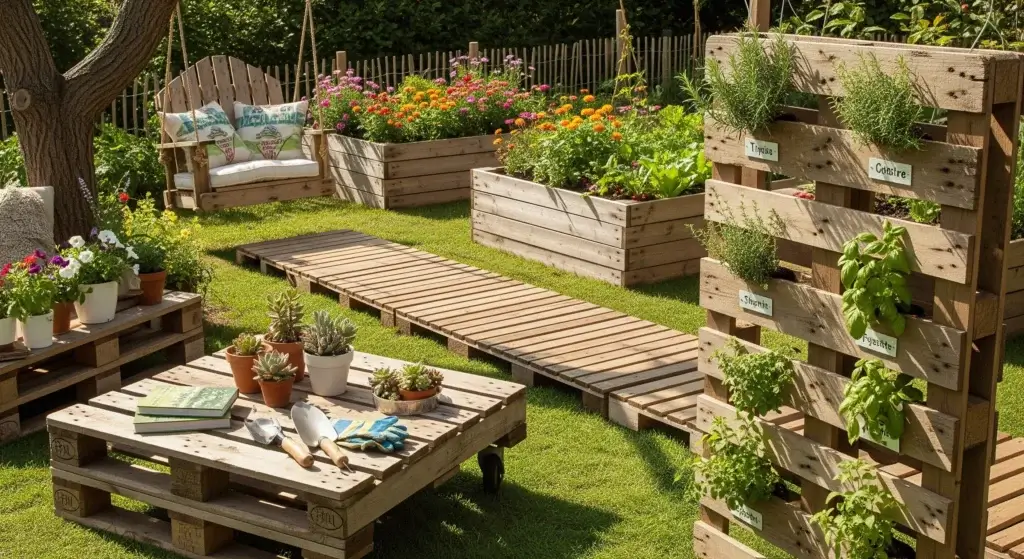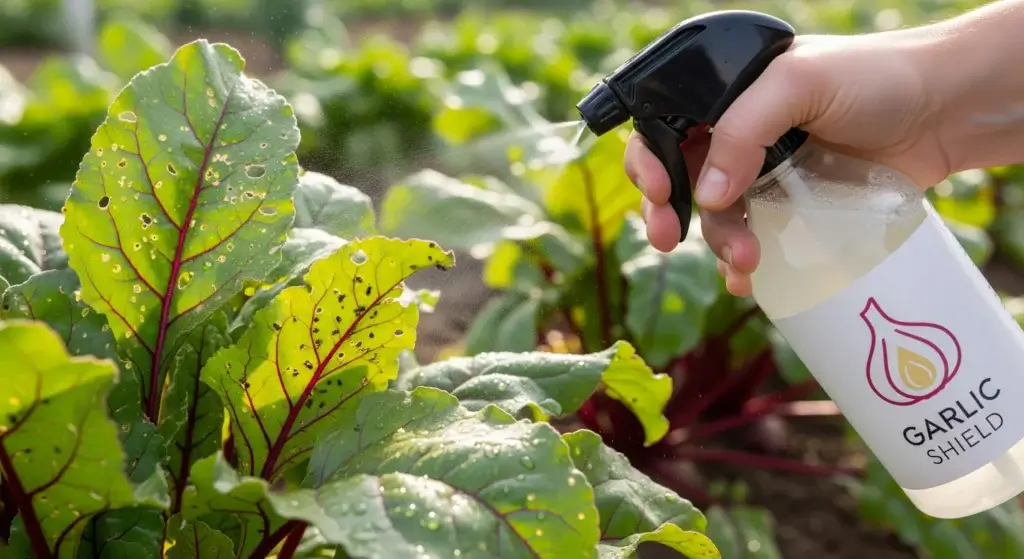
Tomatoes are a staple in many kitchens, and nothing beats the taste of a fresh, homegrown tomato.
However, not everyone has the space for a traditional garden.
This is where a DIY container tomato garden comes in handy.
Whether you have a small balcony or a sunny windowsill, you can enjoy the satisfaction of growing your own tomatoes.
This guide will walk you through the process, from choosing the right containers to harvesting your delicious tomatoes.
Advantages of DIY Container Tomato Gardens
Growing tomatoes in containers comes with several distinct advantages that make it a practical choice for many gardeners.
Here’s a detailed look at why container gardening can be beneficial:
Space efficiency
Container gardening is especially useful for those with limited outdoor space, such as apartment dwellers or people with small yards.
Tomatoes can thrive in containers on balconies, patios, or even windowsills.
This method allows you to grow fresh tomatoes without needing a large garden area.
- Read also: DIY Tomato Trellis Ideas: Make Your Garden a Blast from the Past
- Read also: Step by Step Guide: How to Grow Cherry Tomatoes in a Container
Mobility
One of the major benefits of container gardening is the ability to move the plants.
If you notice that one area of your garden receives more sunlight than another, you can easily reposition your tomato containers to take advantage of the best light.
Similarly, if there’s a risk of severe weather, you can move the containers to a more sheltered spot, protecting your plants from harsh conditions.
Control over soil quality
When growing tomatoes in containers, you have greater control over the soil quality.
This is important because good soil is essential for healthy plant growth.
In containers, you can use high-quality potting mix tailored for tomatoes, which reduces the risk of soil-borne diseases that can be a problem in traditional garden beds.
Pest management
Container gardening can make pest management simpler.
With plants elevated and contained, it’s easier to spot and address any pest issues.
You can more effectively manage and control pests and diseases, as you can move the containers to inspect the plants closely and apply treatments if needed.
Accessibility
For individuals with physical limitations, container gardening offers a more accessible option.
You can place containers at a height that is comfortable for you, such as on a table or raised garden bed.
This eliminates the need to bend down or kneel, making gardening tasks like planting, watering, and harvesting easier and more comfortable.
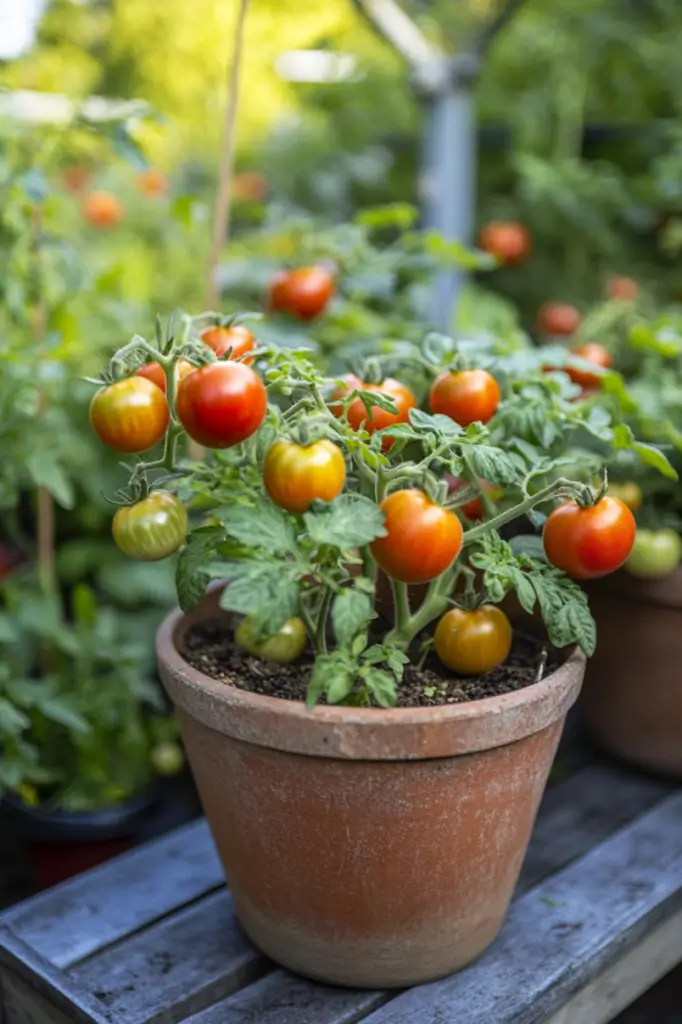
Types of Containers
Choosing the right container for growing tomatoes can make a big difference in your gardening success.
Here’s a closer look at the different types of containers you might consider:
Plastic pots
Plastic pots are a popular choice for many gardeners.
They are lightweight, which makes them easy to move around.
Additionally, they are often quite affordable and come in a variety of sizes, allowing you to choose the one that best fits your space and tomato variety.
Terracotta pots
Terracotta pots are known for their attractive, natural appearance.
They’re made from clay and are great for adding a touch of elegance to your garden.
One of their advantages is their breathability, which helps with air circulation around the roots.
Fabric pots
Fabric pots, often referred to as grow bags, are becoming increasingly popular among gardeners.
These pots are made from a breathable fabric that allows air to reach the roots, promoting healthy root growth.
Self-watering containers
Self-watering containers are a great option for busy gardeners.
These containers come with a built-in reservoir that provides a steady supply of water to the plants.
This system reduces the need for frequent watering and helps ensure that your tomatoes get consistent moisture.
Upcycled containers
Using upcycled containers is a creative and eco-friendly way to garden.
Items like old buckets, barrels, or even tires can be repurposed into planters.
This approach not only helps you save money but also gives your garden a unique and personal touch.
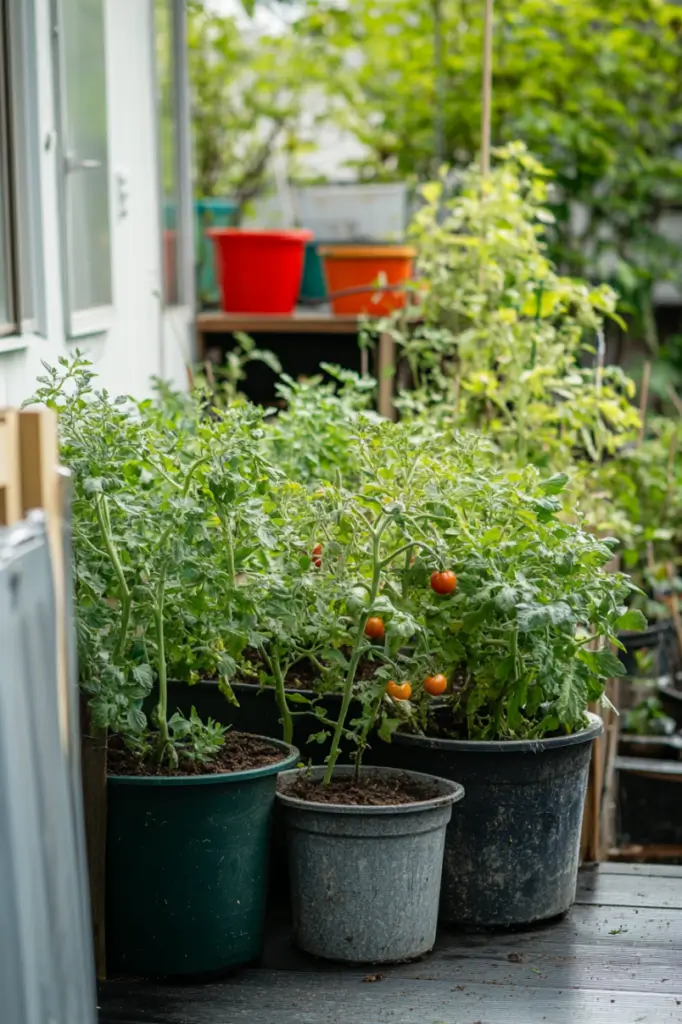
Materials Needed
Before you start your DIY container tomato garden, gather the following materials:
- Containers: Choose the type and size based on your space and aesthetic preferences.
- Potting mix: Use a high-quality, well-draining potting mix designed for container gardening.
- Tomato Plants or Seeds: Choose varieties suited for container gardening, such as cherry tomatoes or dwarf varieties.
- Fertilizer: Opt for a balanced, slow-release fertilizer suitable for tomatoes.
- Support structures: Tomato cages, stakes, or trellises to support the plants as they grow.
- Watering can or hose: Consistent watering is crucial for healthy tomato plants.
Step-by-Step Guide to Building a DIY Container Tomato Garden
Creating a DIY container tomato garden can be a rewarding and enjoyable project. Here’s a detailed, step-by-step guide to help you get started:
Select containers
Choose containers that are large enough to support your tomato plants.
A good size for most tomato varieties is a 5-gallon container.
Make sure the containers have drainage holes at the bottom.
Proper drainage is crucial because it prevents water from pooling at the bottom, which can lead to root rot and other issues.
Prepare potting mix
Fill your containers with a high-quality, well-draining potting mix.
This mix should be designed for container gardening and usually includes ingredients like peat moss, vermiculite, or perlite.
Leave a few inches of space at the top of the container.
This space will help prevent soil from spilling out when you water the plants.
Plant tomatoes
If you’re starting with seeds, plant them according to the instructions on the seed packet.
This typically involves planting the seeds at a specific depth and spacing them correctly.
If you’re using seedlings, plant them deeper than they were in their nursery pots.
Cover the stem up to the first set of leaves.
Planting deeply encourages the tomato plant to develop a strong, healthy root system.
Add support
Insert a tomato cage or stake into the container at the time of planting.
Doing this now, rather than later, helps avoid disturbing the plant’s roots.
The support structure will help keep the tomato plant upright and prevent it from sprawling on the ground, which can reduce the risk of diseases and make harvesting easier.
Watering
After planting, water your tomatoes thoroughly.
Consistent moisture is key to healthy tomato plants.
Aim to provide about 1 to 1.5 inches of water per week.
This can be adjusted depending on weather conditions and how quickly the soil dries out.
Keep an eye on your plants and water when the top inch of soil feels dry.
Fertilize
Tomatoes are heavy feeders and will benefit from regular feeding.
Apply a slow-release fertilizer when you first plant the tomatoes.
This will provide essential nutrients over time.
Every two weeks, use a liquid fertilizer to give your plants a boost.
Follow the instructions on the fertilizer package to avoid overfeeding, which can harm your plants.
Positioning
Tomatoes thrive in sunny conditions.
Place your containers in a location where they will receive at least 6 to 8 hours of direct sunlight each day.
A sunny spot helps the plants grow strong and produce plenty of fruit.
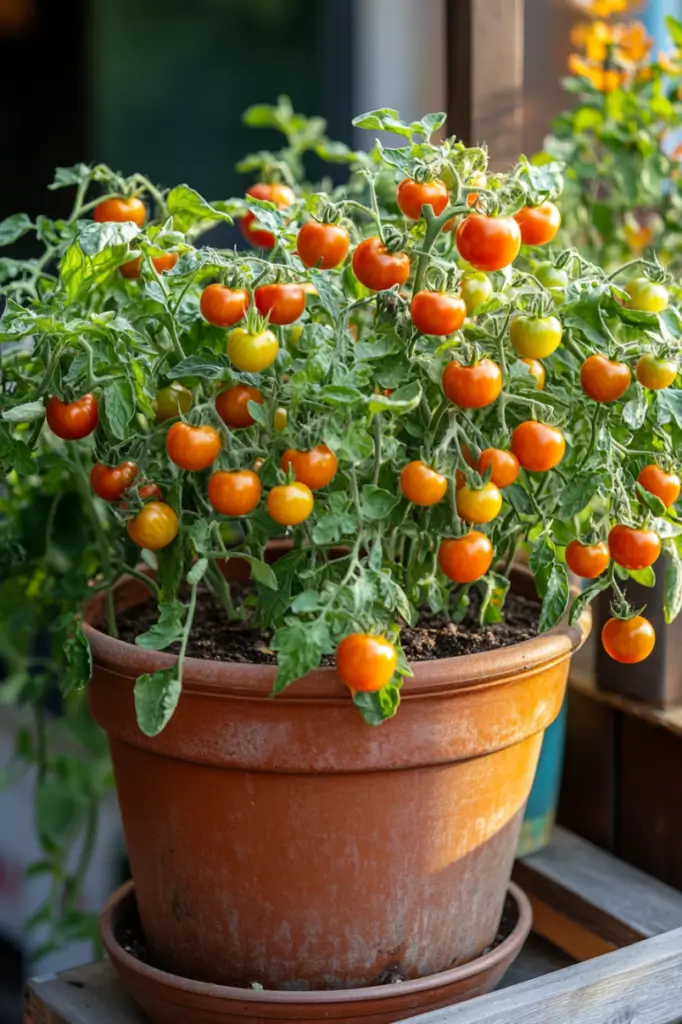
Tips for Growing Tomatoes in Containers
Growing tomatoes in containers can be a fun and rewarding experience.
Here are some practical tips to help you achieve the best results:
Choose the right varieties
For container gardening, opt for dwarf or determinate tomato varieties.
Dwarf varieties stay compact and are well-suited for small spaces, while determinate varieties grow to a certain height and then stop, making them ideal for containers.
They also tend to produce all their fruit at once, which can be easier to manage in a container setting.
Monitor watering
Containers can dry out more quickly than garden beds because they have less soil to retain moisture.
Regular watering is essential to keep your tomato plants healthy.
To help retain moisture and reduce the need for frequent watering, consider adding a layer of mulch on top of the soil.
Mulch helps keep the soil moist and can also prevent weeds from growing.
Rotate containers
If you’re growing tomatoes on a sunny windowsill or in a spot with limited sunlight, rotate the containers regularly.
This ensures that all sides of the plant receive equal sunlight, promoting even growth and preventing the plants from becoming lopsided or leaning toward the light.
Prune and pinch
Pruning your tomato plants helps improve air circulation and encourages better fruit production.
Remove suckers, which are the small shoots that grow between the main stem and branches.
This helps the plant focus its energy on producing fruit rather than excess foliage.
Regular pinching can also help manage the plant’s growth and maintain its shape.
Watch for pests and diseases
Keep a close eye on your tomato plants for any signs of pests or diseases.
Common pests include aphids and whiteflies, while diseases like blight can affect tomato plants.
Inspect your plants regularly and use natural treatments like neem oil or insecticidal soap to manage pests.
If you spot any issues early, you can often address them before they become serious problems.
Harvest regularly
Tomatoes should be picked as soon as they ripen.
Harvesting regularly encourages the plant to continue producing fruit.
Waiting too long to pick ripe tomatoes can lead to overripe fruit or even attract pests.
By regularly harvesting, you ensure a steady supply of fresh tomatoes and keep your plants productive.
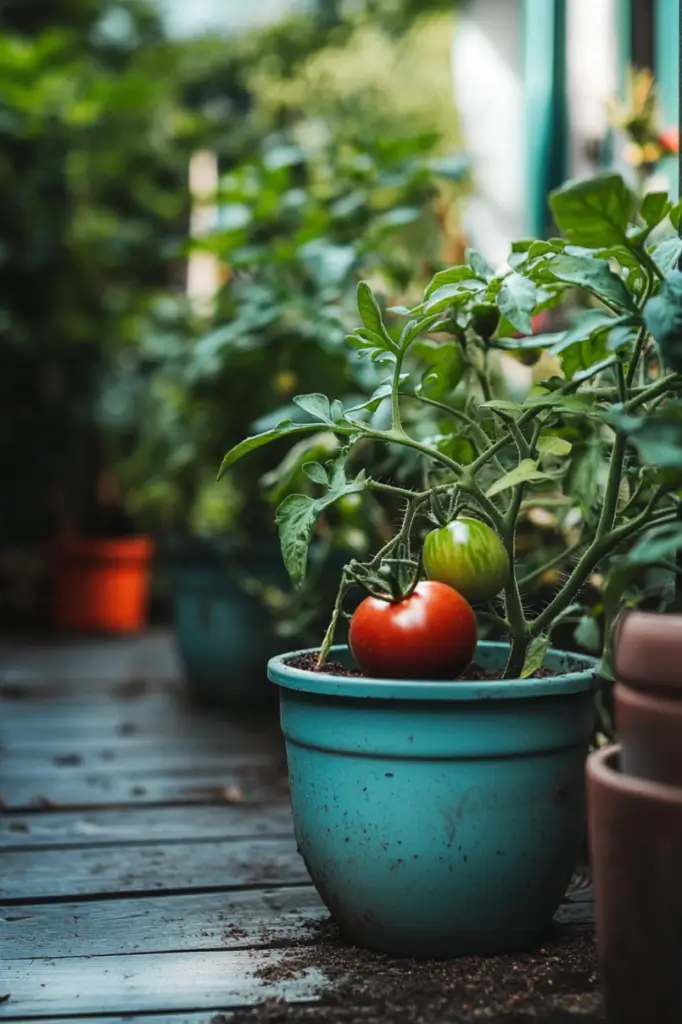
- Read also: Unexpected Allies: Best Companion Planting for Your Tomatoes
- Read also: Cracking the Code: Understanding Soil pH for Luscious Tomatoes
Conclusion
A DIY container tomato garden is a rewarding and practical way to enjoy fresh tomatoes, even in small spaces.
With the right materials, a bit of care, and some useful tips, you can successfully grow delicious tomatoes at home.
Whether you’re a seasoned gardener or a beginner, container gardening offers a flexible and convenient solution for growing your own food.


